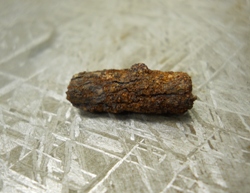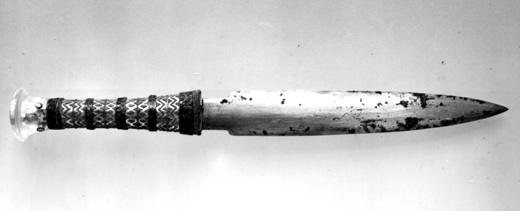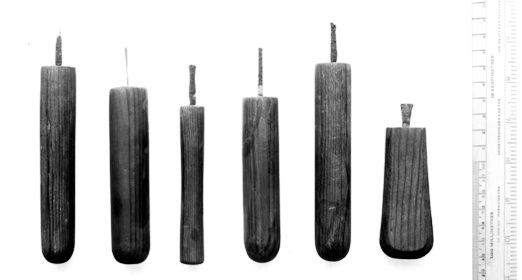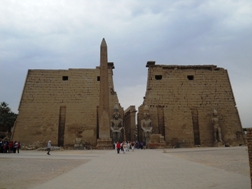 Meteoritics and Egyptology, two very different disciplines, recently collided in the laboratory, write Diane Johnson and Joyce Tyldesley*.
Meteoritics and Egyptology, two very different disciplines, recently collided in the laboratory, write Diane Johnson and Joyce Tyldesley*.
Even though they had access to abundant supplies of iron in both Egypt and the Sinai peninsula, ancient Egyptian metalworkers did not develop iron production technologies before 600 BC. This appears to have been a deliberate choice; textual sources indicate that they were aware of iron from early in Egyptian history, when iron ores were ground up to create pigments used in art and cosmetics.
Although there are no signs of early iron manufacture, archaeology has shown that elite Egyptians were, very occasionally, buried with iron grave-goods long before that date. This raises a number of intriguing questions. Did the ancients actually work iron far earlier than has ever been recognised? Was iron the occasional, accidental, by-product of copper smelting? Did iron regularly enter Egypt through trade and if so, where did it originate? Or, as the earliest archaeologists suggested, was this meteoric iron: iron that had fallen from the sky, home of the gods?
If it was meteoric in origin, did the idea that it was the gift of the gods influence the perception and use of the metal? As one of us (DJ) is fascinated by meteorites, the other (JT) fascinated by early Egypt, and both of us are fascinated by ancient riddles, we could not resist the temptation to investigate further.
EXCAVATION

Five thousand three hundred years ago, in the pre-literate time before Egypt became a single state ruled by a pharaoh, a man was buried in a sandy grave in the Gerzeh cemetery (70km south of modern Cairo). We know very little about this anonymous man, but we can deduce that he was an important member of his community because his body was surrounded by valuable grave-goods - an ivory pot, a stone palette to grind his cosmetics and a copper harpoon - and adorned with bead jewellery made from precious raw materials including gold, carnelian and iron. So rare were his tubular iron beads that only one other grave in the extensive cemetery included anything similar.
Pictures: Above, the Gerzel bead, pictured on an etched slice of iron meteorite, showing characteristic Widmanstätten structure. Below, the bead showing optical and virtual X-ray data.
In 1911 the man and his beads were exhumed when archaeologist Gerald Wainwright excavated the Gerzeh cemetery. This unexpected find of iron artefacts in a well-dated context predating the official start of the Egyptian Iron Age by over 2500 years caused archaeologists to question their understanding of ancient Egyptian metalworking technologies. The question was, however, quickly answered when early analysis indicated that the beads were rich in nickel.
 As all meteorite iron is nickel-rich, this was considered conclusive evidence of a meteoritic origin for the metal. It seemed that the ancients had simply found the iron and worked it as they would have worked copper, without any real understanding of its nature. Wainwright, believing that the deliberate inclusion of iron beads in high-status burials indicated that meteorites had religious importance, went on to develop numerous theories involving meteorite worship in ancient Egypt.
As all meteorite iron is nickel-rich, this was considered conclusive evidence of a meteoritic origin for the metal. It seemed that the ancients had simply found the iron and worked it as they would have worked copper, without any real understanding of its nature. Wainwright, believing that the deliberate inclusion of iron beads in high-status burials indicated that meteorites had religious importance, went on to develop numerous theories involving meteorite worship in ancient Egypt.
ANALYSIS
In the 1980s, doubt was cast on the meteoritic origin of the Gerzeh beads when archaeo-metallurgists suggested that early nickel-rich iron could have been produced from terrestrial resources, using naturally nickel-rich iron ores or additives. Given the highly oxidised state of the Gerzeh iron beads, and their limited early analysis (which was neither well-published nor conducted to modern standards) this possibility had to be considered. So we decided to start our investigation by re-examining one of the iron beads currently held in the collections of The Manchester Museum.
Non-destructive methods of analysis were employed; electron microscopy to examine surface structures and chemistry and micro x-ray Computer Tomography (CT) to reveal internal structures. We found that the bead itself has the microstructure and chemistry of an iron meteorite, so its origin therefore seems clear. We also found indications of the manufacture method; bending points were clearly seen in virtual X-ray CT slices through the bead, indicating that the meteorite was beaten into a thin sheet and subsequently bent into a tube shape. This allowed it to be strung on a flax fibre thread, traces of which are still preserved within the bead.
The full meaning of the inclusion of meteorite iron beads in this particular grave remains to be fully understood. As the burial predates writing, we have no textual references to help us. The iron could have come from a small local meteorite fall, or it could have arrived at the site through trade. The cemetery did yield several materials from non-local sources, including lapis lazuli and obsidian, which could have been imported from as far away as Ethiopia and Afghanistan.
COMPARISONS
Egyptologists have speculated for many years on the use of meteorite iron by the ancient Egyptians. Unfortunately, it is difficult to reach an accurate assessment of the amount of iron in circulation before 700 BC.
 The ancient Egyptians built their houses and palaces from mud bricks, and situated them close to water sources. Over time, the vast majority of their settlements, together with any iron they might once have held, have simply dissolved into the landscape. Graves and tombs, cut into the hot, dry desert sands and cliffs, were intended to be more permanent and so offer a more reliable source of evidence, although even here there may be problems.
The ancient Egyptians built their houses and palaces from mud bricks, and situated them close to water sources. Over time, the vast majority of their settlements, together with any iron they might once have held, have simply dissolved into the landscape. Graves and tombs, cut into the hot, dry desert sands and cliffs, were intended to be more permanent and so offer a more reliable source of evidence, although even here there may be problems.
Picture: Iron headrest from Tutankhamen's tomb.
Many of Egypt’s cemeteries were investigated over a century ago, before modern standards of excavation were developed, when it was not uncommon for smaller and seemingly insignificant finds to be ignored in the quest for more valuable grave goods. It also seems likely that cultural expectation would play a part in the recovery of iron from pre- Iron Age archaeological sites: if excavators “knew” that iron could not be present, any find of iron would probably be classified as intrusive (later dating) and simply thrown away. Despite these problems, more than 20 early iron artefacts have been found in securely dated contexts. These came from two tombs on the west bank of the Nile at ancient Thebes (modern Luxor). The majority of these finds have been analysed as ‘nickel-rich’.
 Picture: The 'Eye of Horus' iron amulet from Tutankhamen's grave goods.
Picture: The 'Eye of Horus' iron amulet from Tutankhamen's grave goods.
More than 1000 years after these beads were committed to the Gerzeh grave, a part-iron amulet was placed in the tomb of Queen Ashait (Deir el-Bahri, Thebes). Her amulet takes the form known as a pesesh-kef; it is modelled on the figure of a person from the chest to the top of the head, in a similar style to a death mask, but with a small blade mounted downwards from its base.
Initially it was thought that her amulet had been made entirely from silver, but analysis subsequently showed that blade was made of nickel-rich iron, although its exact composition has yet to be published. Pesesh-kef blades were traditionally associated with childbirth (when they were used to cut the umbilical cord of newborn babies) and with the re-birth after death. They were used in ceremonies designed to animate the inert including the ‘Opening of the Mouth’ - a ritual performed at the entrance to the tomb, which would transform the mummy into a latent being with the potential for life.
 Picture: Iron dagger from Tutankhamen's grave goods.
Picture: Iron dagger from Tutankhamen's grave goods.
When King Tutankhamen died in approximately 1327 BC, he and his grave goods were buried in a tomb in the Valley of the Kings. Unlike Ashait’s, Tutankhamen’s tomb was preserved more or less intact, although archaeology indicates that there had been two robberies soon after his funeral. Several iron artefacts were found among Tutankhamen’s surviving grave goods. These included a set of 16 model chisels with iron blades set in wooden handles, stored in a room opening off the burial chamber. As the chisel blades are all less than 1mm thick, they would have been too fragile to use as practical tools. It is, however, possible that they were used in Tutankhamen’s own Opening of the Mouth ceremony.
Three iron artefacts were found wrapped within Tutankhamen’s mummy bandages. As the body was the most important element within the tomb, this placing indicates the high ritual and financial value attached to iron by those who wrapped the king for death. A miniature model head-rest (the hard ancient Egyptian equivalent of a pillow) was discovered lying directly behind Tutankhamen’s head, inside his gold death mask. The head-rest had been roughly constructed by welding together pieces of iron, probably at too low a temperature.
 Picture: Tutankhamen's model iron chisels. See text for explanation.
Picture: Tutankhamen's model iron chisels. See text for explanation.
Wrapped on the right side of the abdomen was an iron ‘Eye of Horus’ amulet attached to a golden bracelet. The “eye of Horus” was a popular funerary amulet, symbolising protection, royal power and good health. Also wrapped with the mummy was a large and extremely well-made dagger with a rock-crystal pommel, gold sheath and iron blade which, as the excavators noted, was still extremely sharp when discovered lying along the king’s right thigh. A second dagger recovered from the mummy was entirely of gold.
Apart from the dagger blade, all of Tutankhamen’s iron goods are crudely made. Those which have been analysed have nickel-rich iron chemistry. This suggests that they were of local, Egyptian, manufacture with the meteoric iron being hammered into shape by craftsmen unaccustomed to working with such hard, high-temperature metals. In contrast, recent analysis of the well-made dagger blade recorded three weight percent nickel content, which suggests a smelted origin. Only further testing can confirm this.
WRITINGS
Textual evidence indicates that limited amounts of iron were imported into Egypt from neighbouring territories during the reigns immediately preceding Tutankhamen’s. One such text is a letter written by Tushratta, king of Mitanni (a land covering the modern regions of eastern Turkey, northern Syria and western Iraq), to Amenhotep III, king of Egypt. Amenhotep was almost certainly the grandfather and revered role-model of Tutankhamen.
The letter details the dowry of Tushratta’s daughter, who was to be sent to Egypt to marry Amenhotep. Intriguingly, it mentions a dagger blade of habalkinu: a word derived from the ancient Hittite language which may be translated as “steel”. It is therefore a distinct possibility that Tushratta’s dagger, initially sent to Amenhotep, was inherited by his grandson Tutankhamen, used for ritual and maybe practical purposes throughout his reign, and buried alongside him as a valued symbol of kingship and kinship.
The earliest ancient Egyptian (hieroglyphic) word for iron was the subject of great debate by early linguists, who frequently confused copper and iron in their translations. The word bia was eventually recognised as “iron”, but it may actually refer to a range of hard, dense, metals including iron. The word was used in many texts, including the funerary Pyramid Texts carved on the internal walls of some royal pyramids. These, some of Egypt’s earliest preserved religious writings, date from approximately 2375 BC but are likely to have been composed much earlier. They connect iron with aspects of the sky, with ritual artefacts and with the bones of the dead king who is described as living for ever as an undying star in the sky.
In approximately 1295 BC a new hieroglyphic word appeared. Bia-n-pet literally translates as “iron from the sky”. The new word was applied to all metallic iron from this time onwards. An obvious explanation for the sudden emergence of the new word would be a major event, such as a large impact or shower of meteorites, witnessed by the ancient Egyptian population. This would have left little uncertainty as to where exactly the mysterious iron came from, and would have created a sufficiently strong association between iron and the sky for the new word to become synonymous with all forms of iron. In 2008 a large impact crater formed by an iron meteorite was found in southern Egypt. Although its exact age is unknown, local archaeology suggests that it formed within the last 5000 years, making it a possible candidate event.
RITUALS
 Most of the early examples of iron in Egypt are obviously symbolic or ritual artefacts; the one exception, Tutankhamen’s dagger, may have been either a ritual or a practical tool, or both. All the examples were recovered from graves, and therefore are likely to have some ritual connection with the funeral and/or rebirth of the deceased. This ritual link is also found in early funerary texts, where the association with the Opening of the Mouth ceremony is particularly clear.
Most of the early examples of iron in Egypt are obviously symbolic or ritual artefacts; the one exception, Tutankhamen’s dagger, may have been either a ritual or a practical tool, or both. All the examples were recovered from graves, and therefore are likely to have some ritual connection with the funeral and/or rebirth of the deceased. This ritual link is also found in early funerary texts, where the association with the Opening of the Mouth ceremony is particularly clear.
It may be that iron was allowed an important role in this ceremony because meteoritic iron was associated with meteors and thunderbolts; powerful natural phenomena whose own inherent power might increase the potency of the ritual. A specific association of iron blades with the adze, a bladed tool used as a ritual implement, suggests a link to the stars themselves, while the constellation Ursa Major (aka ‘The Plough’ or ‘Big Dipper’) forms the shape of the adze, the stars in Ursa Major were considered to be ‘imperishable’ stars, the name used by the ancient Egyptians for stars not seen to set or rise because of their proximity to the northern celestial pole. Dead and reborn kings were identified with these special stars.
Meteorites may have played a more direct role in state religion. The ‘Benben Stone’ was the focus of worship in the temple of the sun god Re at Heliopolis. The word benben is derived from the verb weben which means ‘to shine’. It may therefore be associated with the first ray of sunlight, or with the mound of creation that emerged from the waters of chaos at the beginning of time. The original benben stone was lost in antiquity, but contemporary illustrations indicate that it was a pyramid or cone-shaped rock, which has led to suggestions that it may have been a meteorite.
For most of Egypt’s long history, iron was a rare and exotic material sourced from meteorites. As iron fell to Earth, it is likely to have been regarded as a ‘gift of the gods’, which would have given it a powerful ritual magic. However, the technology, chronology and etymology of iron and the iron smelting process in ancient Egypt are poorly understood, creating many challenges when attempting to understand the source and functions of iron artefacts.
Because of the possible variation in smelting materials, we cannot easily know which nickel-rich artefact has been formed from meteorite iron and which has been smelted. Ultimately, this can only be determined by further detailed structural and chemical analysis of individual objects. We hope that with further investigations we will be able to clarify the use and importance of iron – both meteoric and terrestrial - in ancient Egypt.
Further reading:
- Johnson, D., Tyldesley, J., Lowe, T., Withers, P.J., Grady, M.M. (2013) Analysis of a prehistoric Egyptian iron bead with implications for the use and perception of meteorite iron in ancient Egypt. Vol.48, 6, 997-1006, Meteoritics and Planetary Science.
- Ogden, J. (2000), Metals, in I. Shaw and P. Nicholson (eds) Ancient Egyptian Materials and Technology, Cambridge University Press, Cambridge: 148-176.
- Tyldesley, J. (2010), Myths and Legends of Ancient Egypt, Viking Penguin, London.
Credits
Black & white images are Copyright, Griffith Institute, University of Oxford. Used with permission.
Authors
*
Diane Johnson works with meteorites in the Planetary and Space Sciences group at the Open University, UK. She also studies Egyptology with the University of Manchester.
[email protected].
Joyce Tyldesley is Senior Lecturer at the University of Manchester, where she teaches Egyptology online. Her research interests include the development of Egyptian mythology.
[email protected].